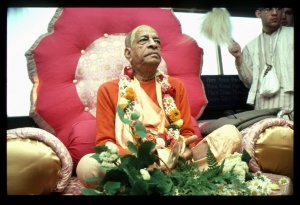CC Adi 2.52 (1975)

A.C. Bhaktivedanta Swami Prabhupada
TEXT 52
- e sabhāra darśanete āche māyā-gandha
- turīya kṛṣṇera nāhi māyāra sambandha
SYNONYMS
e—this; sabhāra—of the assembly; darśanete—in seeing; āche—there is; māyā-gandha—connection with māyā; turīya—the fourth; kṛṣṇera—of Lord Kṛṣṇa; nāhi—there is not; māyāra—of the material energy; sambandha—connection.
TRANSLATION
"Superficially we see that these puruṣas have a relationship with māyā, but above them, in the fourth dimension, is Lord Kṛṣṇa, who has no contact with the material energy.
PURPORT
The three puruṣas-Kāraṇodakaśāyī Viṣṇu, Garbhodakaśāyī Viṣṇu and Kṣīrodakaśāyī Viṣṇu-all have a relationship with the material energy, called māyā, because through māyā They create the material cosmos. These three puruṣas, who lie on the Kāraṇa, Garbha and Kṣīra oceans, are the Supersoul of everything that be: Kāraṇodakaśāyī Viṣṇu is the Supersoul of the collective universes, Garbhodakaśāyī Viṣṇu is the Supersoul of the collective living beings, and Kṣīrodakaśāyī Viṣṇu is the Supersoul of all individual living entities. Because all of Them are somehow attracted to the affairs of the material energy, They can be said to have some affection for māyā. But the transcendental position of Śrī Kṛṣṇa Himself is not even slightly tinged by māyā. His transcendental state is called turīya, or the fourth-dimensional stage.